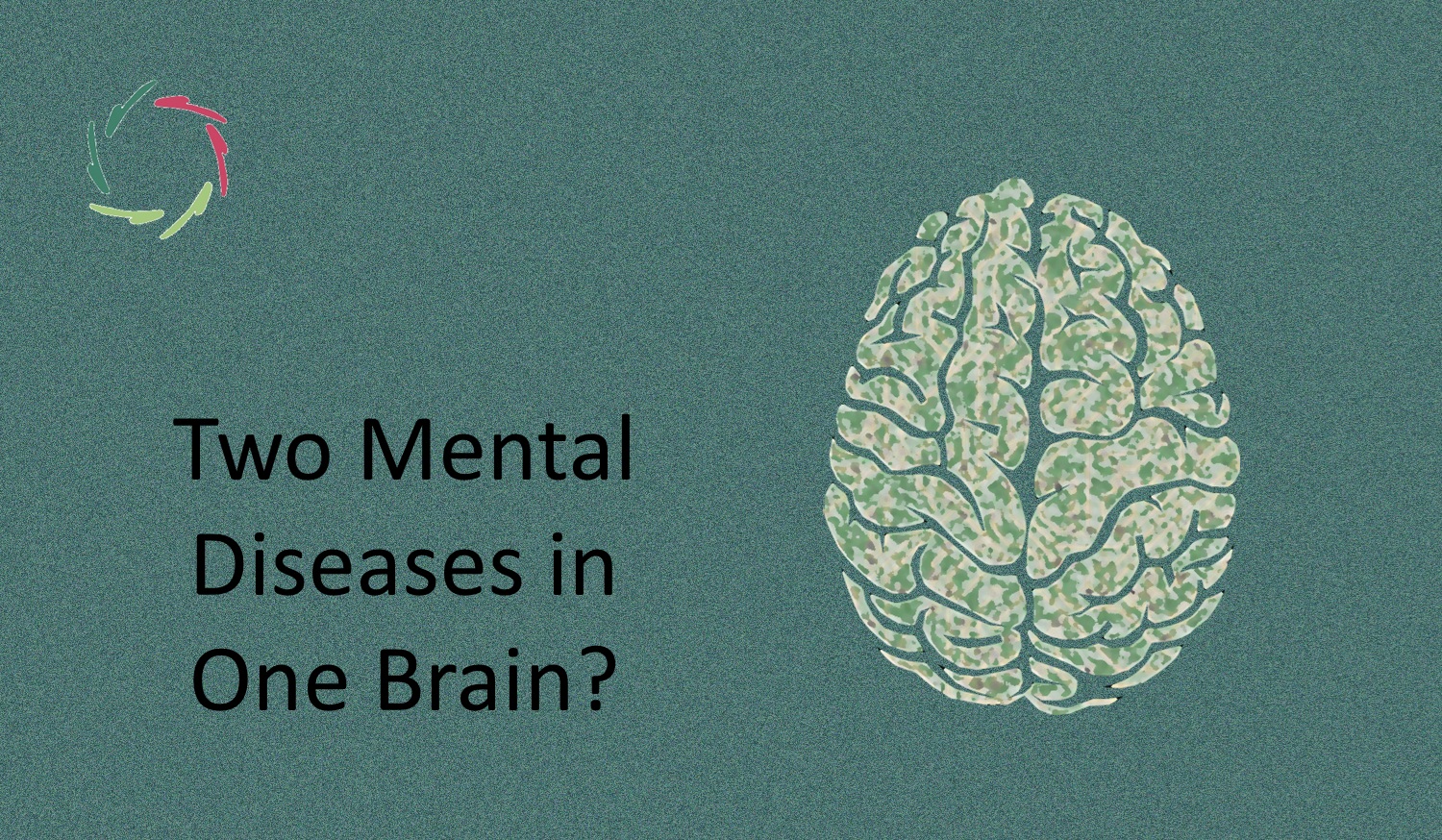Two Mental Diseases in One Brain?

Can one have two mental diseases at the same time? It’s a question that has sparked ongoing debate, as science has yet to offer a definitive answer.
This blog explores the broader implications of this query for mental health care and research. While the intent is not to challenge current therapeutic practices, it does open the door for reflection and meaningful dialogue between patients and their therapists.
This blog should be no reason for any discontinuation of therapy as described by an officially accredited therapist.
The challenge of dual diagnosis
It is possible to have two mental diagnoses simultaneously, but what does that mean? A diagnosis is essentially a label for a set of symptoms that frequently occur together. It does not necessarily indicate a single, known cause — or even a distinct brain deficit. When abnormalities are detected in the brain, they often raise more questions than answers: Are they causes, consequences, or merely additional symptoms of the condition?
When two mental diseases appear simultaneously, two approaches can be taken:
- The symptoms can be grouped together into a new diagnosis.
- The symptoms can remain separate, resulting in two distinct diagnoses.
These approaches reflect the broader conversation about how mental health conditions are understood and classified, leading us into the debate between dimensional (one set of symptoms) and categorical (two sets) perspectives.
[For more about the two approaches, see the addendum.]
Beyond labels: a fluid understanding
Dimensional and categorical approaches offer two lenses for viewing mental health. While categorical systems rely on distinct boundaries between disorders, dimensional perspectives emphasize the spectrum-like nature of mental health. This fluidity aligns well with the AURELIS philosophy, which sees mental health challenges as dynamic, deeply interconnected processes rather than rigidly defined states. Moreover, there is an increasing recognition of dimensional approaches in research, especially with projects like the National Institute of Mental Health’s Research Domain Criteria (RDoC).
This perspective fosters Compassionate and personalized care. Rather than isolating symptoms into discrete categories, it encourages addressing underlying patterns and engaging the deeper processes that give rise to mental health conditions.
Implications of subconceptual processing
Subconceptual processing sheds light on the deeper workings of the mind, offering profound implications for how we understand mental health and personal growth. At this level, mental disorders are not isolated entities but manifestations of dynamic, overlapping patterns within the brain. This challenges traditional diagnostic models, urging us to move beyond rigid categorizations and address the fluid interplay of symptoms.
By recognizing this complexity, we can foster more Compassionate and effective approaches to mental health. Tools like autosuggestion engage these deeper patterns, inviting growth from the inside out. Rather than suppressing symptoms, we work with the mind’s natural processes, promoting lasting harmony and well-being. In this way, subconceptual processing bridges the gap between modern neuroscience and the timeless wisdom of holistic self-care, embodying the essence of AURELIS.
Case example: anxiety and depression
Anxiety and depression often occur together, making them one of the most common examples of dual diagnosis. At a surface level, they seem like distinct conditions — one characterized by heightened alertness and worry, the other by low energy and despair. However, when viewed through the lens of subconceptual processing, their overlap becomes clear.
Both conditions may arise from shared patterns of neural dysregulation, such as heightened sensitivity in the amygdala or a disrupted stress response system. For instance:
- Chronic anxiety can deplete emotional resources over time, leading to depressive symptoms.
- Persistent depression might foster a sense of helplessness, which exacerbates anxiety.
This interconnectedness highlights the limitations of treating anxiety and depression as separate ‘diseases.’ Instead, interventions that target the deeper patterns – like calming overactive stress pathways, fostering internal resilience, or providing directed support at the meaning level – can address both conditions simultaneously. Tools such as mindfulness, autosuggestion, and Compassionate care tap into this shared foundation, promoting integrated healing rather than symptom-specific fixes.
Further consequences for Lisa and beyond
A dimensional approach aligns with the intricate complexity of the human mind, while a categorical approach offers structure for communication and decision-making. In a world shaped by human limitations, both approaches hold value, and a hybrid system may currently be the most effective path. However, with the advent of advanced A.I. tools like Lisa, this dynamic could evolve. A.I. can navigate complexity far beyond human capability, reducing the reliance on rigid structures. Nevertheless, such structuring may still be necessary when humans are integral to communication and decision-making processes.
Lisa’s ability to function without generating diagnoses – leaving that task to humans – does not detract from her capacity to operate effectively within the complex realities of mental health. On the contrary, her approach highlights the possibility of providing optimal support without the need for traditional diagnostic labels.
If Lisa proves that coachees can be effectively supported without diagnoses, it suggests a broader implication for human healthcare providers. Diagnoses, as framed by the dimensional approach, may hold more importance for the provider’s perspective than for the person receiving care. Lisa’s success could accelerate the adoption of dimensional thinking, not only within her coaching framework but also across the field of mental health.
Ultimately, the goal remains to create an environment where individuals in need receive care that is both compassionate and effective. Preventive support for those at risk of requiring therapy should aim to empower individuals to lead fulfilling, healthy lives — ideally avoiding the need for therapy altogether. In this vision, such an approach could extend to benefit everyone.
―
Addendum: Dimensional vs. categorical approaches in psychiatry
- Categorical Approach
This is the traditional framework used in diagnostic manuals like the DSM (Diagnostic and Statistical Manual of Mental Disorders) and ICD (International Classification of Diseases). It assumes that mental disorders are distinct entities, each with a defined set of criteria. A person either has the disorder or they don’t. This “yes or no” approach simplifies diagnosis and communication among professionals.
For example, Major Depressive Disorder (MDD) is diagnosed if a person meets specific criteria like persistent low mood, lack of energy, and other symptoms for at least two weeks.
Strengths: Useful for research, treatment guidelines, and insurance claims. It provides structure and clarity for clinicians and patients.
Limitations: It overlooks the complexity and fluidity of mental health conditions, creating artificial distinctions between disorders (e.g., depression vs. anxiety) even when symptoms overlap significantly. Thereby, it risks over-pathologizing normal variations in behavior.
Real-World Implications: A patient is diagnosed with Bipolar Disorder or not. Standard treatments are applied based on diagnosis. A patient with depression and anxiety might receive two separate diagnoses.
- Dimensional Approach
This perspective suggests that mental health exists on a continuum, where disorders are extreme manifestations of common experiences or traits. A key feature is that symptoms vary rather in degree (spectrum of severity) than kind. For example, anxiety might range from mild worry to debilitating panic, with no clear boundary marking a ‘disorder.’
Disorders are viewed as sharing underlying traits or biological markers. For example, depression and anxiety often share symptoms like fatigue or concentration issues.
Strengths: It reflects the complexity of human experience., reducing stigma by showing that mental health conditions are not ‘all-or-nothing.’ Also, it supports personalized care by focusing on individual symptom profiles rather than rigid categories.
Limitations: It can be harder to operationalize research or treatment guidelines. It risks ambiguity in communication among clinicians.
Real-World Implications: The patient is assessed for mood instability on a scale and treated accordingly, whether or not they meet strict diagnostic criteria. Treatment is tailored to symptom severity and patient needs. Their overlapping symptoms are recognized as part of a broader continuum, potentially avoiding redundant or conflicting treatments.


